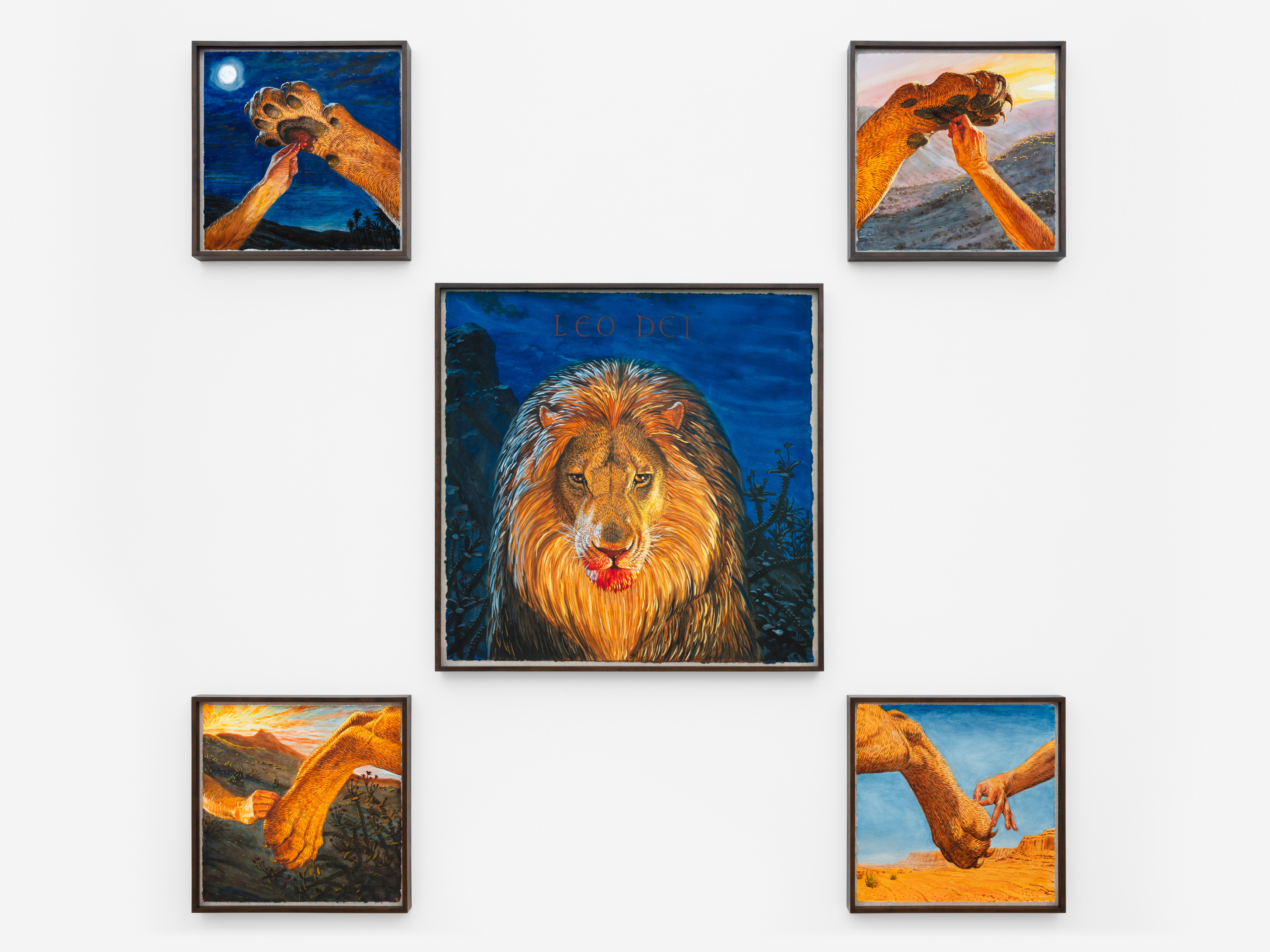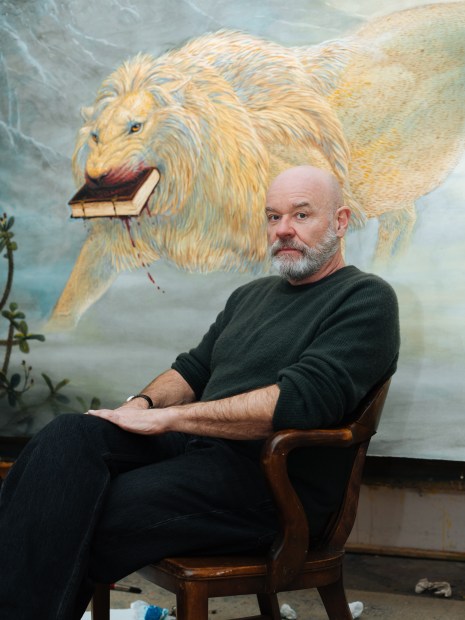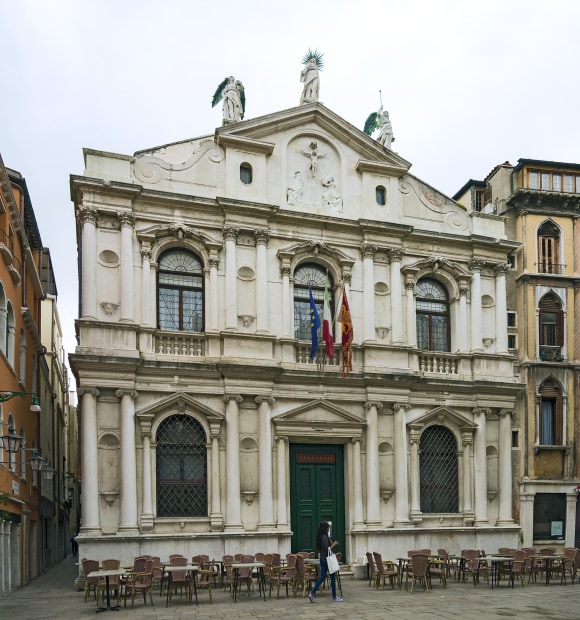Walton Ford: Lion of God
-
-
-
Curated by Udo Kittelmann, the exhibition Lion of God is on view at Ateneo Veneto in Venice through September 22, 2024.
-
-
This year in Venice, Walton Ford unveils a major site-specific exhibition featuring a new body of work conceived in response to the collection of the city’s historical institution Ateneo Veneto di Scienze, Lettere ed Arti. Lion of God is Ford’s first solo exhibition in Italy, consisting of a series of monumental watercolor paintings that explore the historical, biological, and environmental resonance of the subjects of the library’s collection, particularly the figure of the lion in Tintoretto’s Apparizione della Vergine a San Girolamo (The Apparition of the Virgin to St. Jerome) (c. 1580). The presentation spans two rooms in the Ateneo—the Aula Magna on the ground floor, and the Sala Tommaseo hall where Tintoretto’s work has been moved into public view for the exhibition’s duration. Curated by Udo Kittelmann, who worked with Ford on the artist’s 2010-11 traveling European retrospective Bestiarium, Lion of God opens during La Biennale di Venezia’s preview week and remains on view through September 2024.
The exhibition in Venice runs concurrently with Walton Ford: Birds and Beasts of the Studio, a major solo exhibition at The Morgan Library & Museum in New York City celebrating the artist’s drawings. On view from April 12 through October 20, 2024, the exhibition is organized by Isabelle Dervaux, Acquavella Curator and Department Head of Modern and Contemporary Drawings.
Lion of God is organized by Kasmin, New York. Kasmin has presented 11 solo exhibitions of Ford’s work since 1997, including Barbary in 2018—a body of work exploring the fate of the North African Barbary lion. The exhibition has been designed by Studio MDA.
For more information -
Ford has described Tintoretto’s Apparizione della Vergine a San Girolamo as “A poignant entry point into a visual discussion of our relationship with the natural world.” Depicting Saint Jerome in ecstasy, in the midst of a vision in which the Virgin Mary descends from heaven, the historic painting features the lion that the legend describes as befriending St Jerome after he pulls a thorn from its paw. The unlikely bond between the two characters is detailed in the The Golden Legend, a text that was widely circulated in Europe during the late Middle Ages and which has acted as a reference for Ford. Demonstrating a mastery of narrative that Ford himself shares, Tintoretto has rendered his lion in shadow. One of Ford’s new paintings—spanning almost ten feet in length—will invert the Venetian painter’s framing to powerfully foreground the animal’s experience.
Ford’s ongoing philosophical inquiry into the ways in which we interact with and estrange ourselves from the animal species on this planet invokes one of the most urgent questions of our time. Curator Udo Kittelmann says of the project: “In search of finding analogies between the past and the present, Walton Ford’s paintings superimpose intricate natural history depictions with current perceptions and critical commentaries, as well as adding quotes from literary sources from past centuries, rendered in the style of the old masters. In his artworks, which can be seen as satires on political oppression and the exploitation of the environment, he casts doubt on the 'ever new' and the 'ever better’. At the same time Ford has always been raising questions on a diverse range of expectations and established rules in contemporary aesthetics. To be precise, his paintings are a plot about the arrogance of human nature. Yesterday, today and tomorrow.”
-
Video by Mona Productions
-

-
Ford’s work subverts conventions relating to humanity’s attempts to categorize and interpret the natural world by drawing on naturalist sketches and dioramas, zoological records, mythology, fables, and art history. While alluding to the form of naturalist field studies from the 19th century, Ford’s coded poetics are wide-ranging in their references, calling upon the viewer to use these fragmented clues as a guide by which to untangle the folkloric, historical, or imaginary event depicted in the work. Anatomically precise as a result of close observation of taxidermized specimens in museum collections, these works by Ford vividly project the lives, experiences, observations, and hidden histories of their human and animal subjects.
-
-

-

-
-
 Walton FordLeo Dei, 2023watercolor, gouache and ink on paperupper left: 22 3/4 x 22 1/2 inches (57.8 x 57.1 cm)
Walton FordLeo Dei, 2023watercolor, gouache and ink on paperupper left: 22 3/4 x 22 1/2 inches (57.8 x 57.1 cm)
upper right: 22 1/2 x 22 3/4 inches (57.1 x 57.8 cm)
center: 42 1/4 x 42 inches (107.3 x 106.7 cm)
lower left: 22 1/2 x 22 3/4 inches (57.1 x 57.8 cm)
lower right: 22 1/2 x 22 3/4 inches (57.1 x 57.8 cm) -

-

-
-
Video by Mona Productions
-
 Photo by Charlie Rubin
Photo by Charlie Rubin -
 © Staatliche Museen zu Berlin, Nationalgalerie. Photo by Juliane Eirich
© Staatliche Museen zu Berlin, Nationalgalerie. Photo by Juliane Eirich -
 Ateneo Veneto di Scienze, Lettere ed Arti
Ateneo Veneto di Scienze, Lettere ed Arti -
Join our Newsletter
* denotes required fields
We will process the personal data you have supplied in accordance with our privacy policy (available on request). You can unsubscribe or change your preferences at any time by clicking the link in our emails.
-
Explore
-

Les Lalanne: Zoophites
From the Collection of Caroline Hamisky Lalanne
Curated by Paul B. Franklin April 4 – May 9, 2024 509 West 27th Street, New York -

William N. Copley: LXCN CPLY
April 4 – May 11, 2024 297 Tenth Avenue, New YorkWilliam N. Copley: LXCN CPLY will explore the artist’s repertoire of recurring imagery and is the first exhibition to center Copley’s development of his signature visual language. LXCN CPLY draws this thread through five decades of the artist’s career, focusing on a selection of exemplary paintings and drawings from the late 1940s through the 1990s, alongside archival material, documentation and key objects relating to the work on view. The exhibition is co-organized with the William N. Copley Estate, which Kasmin has represented since 2010.
-
-
Explore
- Diana Al-Hadid
- Alma Allen
- Theodora Allen
- Sara Anstis
- Ali Banisadr
- Tina Barney
- Judith Bernstein
- JB Blunk
- Mattia Bonetti
- William N. Copley
- Cynthia Daignault
- Ian Davenport
- Max Ernst
- Liam Everett
- Leonor Fini
- Barry Flanagan
- Walton Ford
- Jane Freilicher
- vanessa german
- Daniel Gordon
- Alexander Harrison
- Elliott Hundley
- Lee Krasner
- Les Lalanne
- Matvey Levenstein
- Lyn Liu
- Robert Motherwell
- Jamie Nares
- Nengi Omuku
- Robert Polidori
- Elliott Puckette
- Alexis Ralaivao
- George Rickey
- James Rosenquist
- Mark Ryden
- Jan-Ole Schiemann
- Joel Shapiro
- Bosco Sodi
- Dorothea Tanning
- Naama Tsabar
- Bernar Venet











